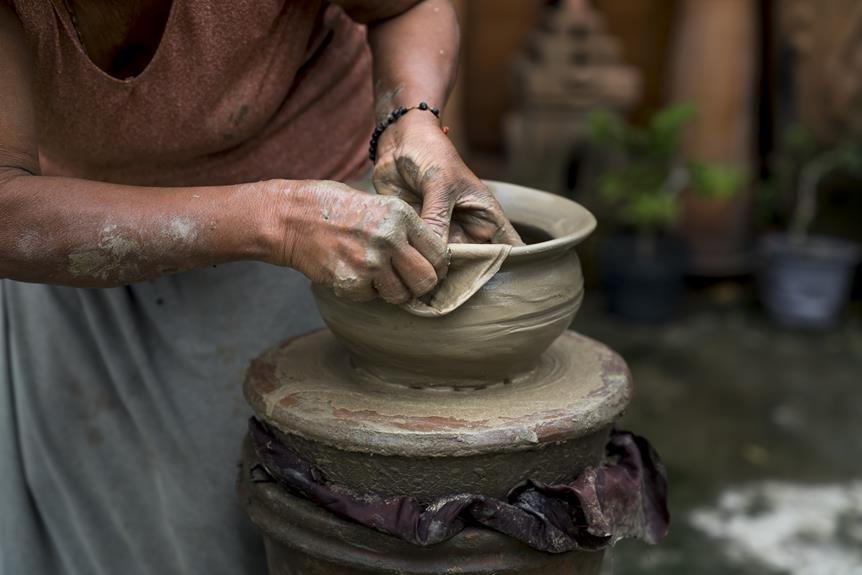Are you tired of dealing with mold in your drain? Don't worry, we've got you covered!
In this article, we'll show you how to effectively clean mold from your drain using simple steps and readily available supplies. Say goodbye to that stubborn mold and keep your drain clean and fresh.
Follow our expert advice and say hello to a mold-free drain!
Key Takeaways
- Inspect for visible signs of mold growth and discoloration in the drain
- Use a mold-specific cleaner or vinegar-water solution to remove visible mold
- Disinfect the drain with a solution effective against mold and mildew
- Take preventive measures, such as regular cleaning, repairing leaks, and ensuring proper ventilation, to avoid future mold growth in the drain
Identifying the Presence of Mold
To identify the presence of mold in your drain, you can start by inspecting for any visible signs of black or greenish growth. Mold thrives in damp and dark environments, making drains an ideal breeding ground. Begin by examining the drain opening and the surrounding area. Look for any discoloration or patches that appear fuzzy or slimy. These are telltale signs of mold growth. Additionally, pay attention to any musty or unpleasant odors emanating from the drain. This can also indicate the presence of mold.
Next, use a flashlight to peer inside the drain pipe. Mold can often be found clinging to the walls of the pipe, especially in areas where water tends to accumulate. Look for a thin, dark film or spots that resemble dirt but can't be easily wiped away. These are likely mold colonies.
If you suspect mold but can't visually confirm its presence, consider conducting a mold test. There are various DIY test kits available that can help you identify mold species and determine the severity of the infestation. However, it's important to note that these tests may not be as accurate as professional assessments.
Gathering the Necessary Supplies
To effectively clean mold in your drain, gather the necessary supplies. Here's a list of items you'll need:
- Cleaning Solution:
- Choose a mold-specific cleaner or create your own solution using a mixture of equal parts water and vinegar. Alternatively, you can use hydrogen peroxide or bleach, but be cautious as they can be harsh on certain surfaces.
- Ensure that the cleaning solution is safe for the type of drain material you have, such as plastic, metal, or porcelain.
- Protective Gear:
- Wear gloves to protect your hands from direct contact with the mold and cleaning solution.
- Put on safety goggles to shield your eyes from any potential splashes or fumes.
- Cleaning Tools:
- Use a stiff-bristle brush or an old toothbrush to scrub away the mold from the drain surfaces.
- A plastic scraper can be handy for removing stubborn mold buildup.
- If necessary, acquire a drain snake or a plunger to clear any blockages caused by mold growth.
Removing Visible Mold From the Drain
To remove visible mold from the drain, begin by inspecting the affected areas for any visible signs of mold growth. This step is crucial in identifying the extent of the problem and determining the appropriate course of action. Grab a flashlight and carefully examine the drain, looking for black or greenish patches, fuzzy or slimy textures, or any other indicators of mold. Pay close attention to the inner walls of the drain, as well as the surrounding surfaces.
Once you have identified the presence of mold, it's time to take action. Put on a pair of rubber gloves to protect your hands from the mold and any cleaning products you may use. Use a stiff brush or an old toothbrush to scrub the visible mold off the surfaces. Start from the top of the drain and work your way down, ensuring thorough coverage. Make sure to scrub the sides, corners, and crevices of the drain to remove all traces of mold.
After scrubbing, rinse the drain with hot water to flush away the loosened mold particles. This will help prevent the mold from spreading further. If necessary, repeat the scrubbing and rinsing process until the visible mold is completely removed.
Remember to dispose of the gloves and toothbrush properly after use to prevent any potential cross-contamination.
Disinfecting the Drain to Prevent Mold Growth
To prevent mold growth, disinfect the drain after removing visible mold. Disinfecting the drain is an important step in preventing the regrowth of mold. Here's what you need to do:
- Choose an appropriate disinfectant: Select a disinfectant that's effective against mold and mildew. Look for products that contain ingredients like bleach or hydrogen peroxide.
- Prepare the disinfectant solution: Follow the instructions on the disinfectant product to prepare the solution. Dilute it with water if necessary.
- Apply the disinfectant: Pour the disinfectant solution down the drain, making sure to coat all surfaces. Use a brush or cloth to scrub the drain walls to remove any remaining mold or mildew.
- Let it sit: Allow the disinfectant to sit in the drain for the recommended amount of time. This will ensure that it effectively kills any remaining mold spores.
- Rinse thoroughly: After the required time has passed, flush the drain with hot water to remove any residual disinfectant and debris.
- Repeat the process: For optimal results, it may be necessary to repeat the disinfection process periodically, especially in areas prone to mold growth.
Preventing Future Mold Growth in the Drain
To prevent future mold growth in the drain, you should regularly clean and maintain the area. Mold thrives in damp and dark environments, so it's important to keep the drain clean and dry.
Start by using a drain brush or a pipe cleaner to remove any debris or residue that may accumulate over time. Make sure to scrub the inner walls of the drain thoroughly to remove any potential mold spores. After cleaning, rinse the drain with hot water to flush out any remaining particles.
In addition to regular cleaning, it's essential to address any underlying issues that may contribute to mold growth. Check for leaks or cracks in the drain pipe and repair them promptly to prevent moisture buildup. Consider installing a drain cover or strainer to prevent hair, soap scum, and other debris from accumulating in the drain.
To further prevent mold growth, ensure proper ventilation in the bathroom or kitchen. Use exhaust fans or open windows to reduce humidity and promote airflow. Avoid leaving wet items, such as sponges or towels, near the drain as they can contribute to moisture buildup.
Conclusion
In conclusion, it's crucial to promptly address and clean mold in drains to prevent further growth and potential health risks.
By identifying the presence of mold, gathering the necessary supplies, removing visible mold, disinfecting the drain, and implementing preventive measures, you can effectively eliminate mold and ensure a clean and healthy drain.
Regular maintenance and proper hygiene practices are essential to prevent future mold growth and maintain a safe environment.






0 Comments